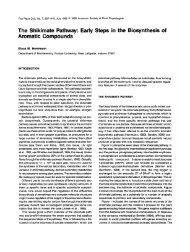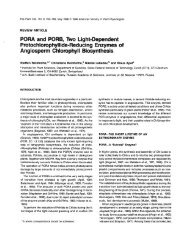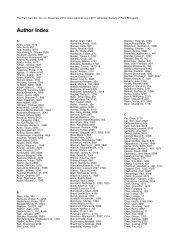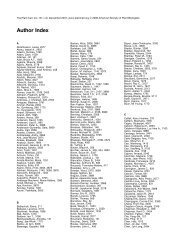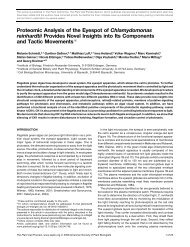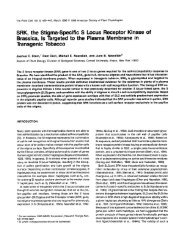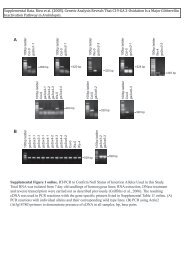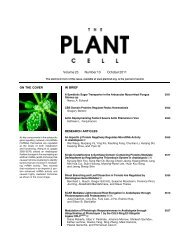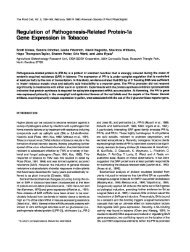The Angiosperm Gibberellin-GID1-DELLA Growth ... - The Plant Cell
The Angiosperm Gibberellin-GID1-DELLA Growth ... - The Plant Cell
The Angiosperm Gibberellin-GID1-DELLA Growth ... - The Plant Cell
You also want an ePaper? Increase the reach of your titles
YUMPU automatically turns print PDFs into web optimized ePapers that Google loves.
taller plants presumably compete more effectively for light and<br />
nutrients when grown in heterogeneous populations (as opposed<br />
to the homogeneous populations typical of modern wheat fields).<br />
In addition, the strength of selection against Rht-B1b indicates<br />
that alleles conferring <strong>DELLA</strong>s resistant to opposition by GA will<br />
be at a competitive disadvantage in many natural environments,<br />
perhaps because the impaired GA opposability imposes a clamp<br />
on the flexibility with which plants can modulate growth in<br />
response to environmental change.<br />
THE GA-<strong>GID1</strong>-<strong>DELLA</strong> MECHANISM: OUTSTANDING<br />
ISSUES AND QUESTIONS<br />
As reviewed above, recent research has shown that the <strong>DELLA</strong>s<br />
are the GA-opposable endogenous plant growth inhibitors<br />
whose existence was first postulated in the late 1950s. We<br />
have summarized the molecular nature of the GA-<strong>GID1</strong>-<strong>DELLA</strong><br />
mechanism, the mechanism via which plants respond to GA, and<br />
argued that this mechanism enables plasticity of growth in<br />
response to environmental variability. We now point out a number<br />
of outstanding issues and questions that are likely fertile<br />
areas for future research.<br />
First, as described above, the recent demonstration that<br />
<strong>DELLA</strong>s interact with PIF3/PIF4 transcription factors provides a<br />
potential general model for understanding how <strong>DELLA</strong>s inhibit<br />
growth. However, the degree of specificity of this interaction<br />
remains unclear. <strong>The</strong> PIFs are a subset of the basic helix-loophelix<br />
(bHLH) family of transcription factors. Perhaps <strong>DELLA</strong>s<br />
interact with a wider spectrum of bHLHs than those defined as<br />
PIFs, thus sequestering various bHLHs away from the gene<br />
promoters that they activate. Such a scenario might explain, at<br />
least in part, the pervasive roles that <strong>DELLA</strong>s appear to play in<br />
angiosperm biology. In addition, since the bHLH transcription<br />
factor PIL5 regulates the expression of <strong>DELLA</strong>-encoding genes<br />
(Oh et al., 2007), it is possible that <strong>DELLA</strong>s feedback regulate their<br />
own expression via interaction with bHLH transcription factors.<br />
Second, this review has shown how GA regulates the growth<br />
inhibition function of <strong>DELLA</strong>s. However, there are increasing<br />
indications that <strong>DELLA</strong> function can also be modified via routes<br />
that do not directly involve GA. Among these possible routes are<br />
transcriptional regulation of genes encoding <strong>DELLA</strong>s (e.g., Oh<br />
et al., 2007; Fukao and Bailey-Serres, 2008), posttranslational<br />
activation of <strong>DELLA</strong>s, and non-GA routes for modulating <strong>DELLA</strong><br />
abundance. One possible route for posttranslational activation of<br />
<strong>DELLA</strong>s is the likely O-GlcNAc transferase activity encoded by<br />
SPY (discussed above), although modulation of this activity has<br />
not yet been shown to regulate <strong>DELLA</strong> activity differentially<br />
in response to physiological or environmental variables. If<br />
O-GlcNAc modification indeed enhances the growth inhibitory<br />
properties of <strong>DELLA</strong>s, it is possible that this modification promotes<br />
the interaction between <strong>DELLA</strong>s and PIF3/4 (or other<br />
bHLHs). A possible point of non-GA regulation of <strong>DELLA</strong> abundance<br />
is the rate of polyubiquitination (and hence destruction) of<br />
<strong>DELLA</strong>s by the SCF SLY1/GID2 E3 ubiquitin ligase. For example,<br />
transgenic overexpression of SLY1 (presumably causing increased<br />
SLY1 availability) promotes growth by increasing <strong>DELLA</strong><br />
destruction (Fu et al., 2004). Thus, SLY1 availability can be a<br />
<strong>Growth</strong> Regulation by GA-<strong>GID1</strong>-<strong>DELLA</strong> 9 of 12<br />
limiting factor in plant growth regulation, and differential regulation<br />
of SLY1 expression is potentially a mechanism via which<br />
different plant signaling pathways may (independently of GA)<br />
regulate plant growth by reducing <strong>DELLA</strong>-mediated growth<br />
inhibition. Future studies will determine the contributions of<br />
these (and other) non-GA routes to the modulation of <strong>DELLA</strong><br />
growth inhibitory function.<br />
Another likely important area of future investigation concerns<br />
the role of <strong>DELLA</strong>s as integrators of growth responses to a variety<br />
of signals. It has been suggested that the GA-<strong>GID1</strong>-<strong>DELLA</strong><br />
mechanism is nodal and provides a mechanism for integrating<br />
multiple input signals into a single growth output (Alvey and<br />
Harberd, 2005). However, many questions remain, not least with<br />
respect to the unraveling of the relative extents to which other<br />
signals (including other hormones) impact upon GA-<strong>GID1</strong>-<br />
<strong>DELLA</strong> activity through regulation of bioactive GA biosynthesis<br />
and inactivation, regulation of <strong>DELLA</strong> susceptibility to GAmediated<br />
opposition of <strong>DELLA</strong> activity (interaction with the GA<br />
receptor and/or subsequent degradation), or modulation of<br />
<strong>DELLA</strong> activity by other means. Furthermore, it is clear that the<br />
GA-<strong>GID1</strong>-<strong>DELLA</strong> mechanism is not the sole mechanism for<br />
integration of growth regulation. For example, <strong>DELLA</strong>s inhibit<br />
hypocotyl growth in response to light, but a <strong>DELLA</strong>-deficient<br />
hypocotyl is still partially photomorphogenetic (is longer than the<br />
wild type in light but not as long as a dark-grown wild-type<br />
hypocotyl; Achard et al., 2007a; Feng et al., 2008). Thus, there<br />
must be additional response integrators that work in conjunction<br />
with the <strong>DELLA</strong>s to inhibit hypocotyl growth in response to light.<br />
By extension, it is likely that there are additional integrators that<br />
coordinate the regulation of growth in response to environmental<br />
variables in general, and determining their relationship with the<br />
<strong>DELLA</strong>s is an important task for the future.<br />
An additional emerging idea concerns the possible relationship<br />
between <strong>DELLA</strong>-mediated growth inhibition and resource<br />
allocation. Essentially, growth inhibition might have adaptive<br />
significance when environmental impacts (both biotic and abiotic)<br />
threaten resource limitation. Prioritization of resource allocation<br />
may result in resources being diverted away from growth<br />
in favor of defense against pathogens or in the adoption of a<br />
strategy that involves reduced resource consumption during a<br />
period of wait for improved environmental conditions. Thus, the<br />
GA-<strong>GID1</strong>-<strong>DELLA</strong> mechanism may enable the robust adaptation<br />
of various aspects of angiosperm biology to environmental<br />
threat.<br />
Finally, it is possible that consideration of the meaning of<br />
“growth inhibition” at the cellular level will prove fruitful. <strong>The</strong><br />
intriguing potential role of reactive oxygen species in GA-<strong>GID1</strong>-<br />
<strong>DELLA</strong>–mediated growth regulation is described above, and this<br />
is likely to be an important area of further investigation. In<br />
addition, plant cell expansion is often characterized as being<br />
the product of opposing forces of (growth-promoting) intracellular<br />
turgor pressure and the (growth-inhibiting) turgor-resisting<br />
forces of the cell wall. This view has parallels with the proposal<br />
that growth is regulated by the opposing forces of GA and a GAopposable<br />
growth inhibitor, the inhibitor of an inhibitor proposal<br />
with which this review began. Could it be that an increase in<br />
<strong>DELLA</strong>-mediated inhibition of growth equates ultimately to an<br />
increase in the resistance of the cell wall?




